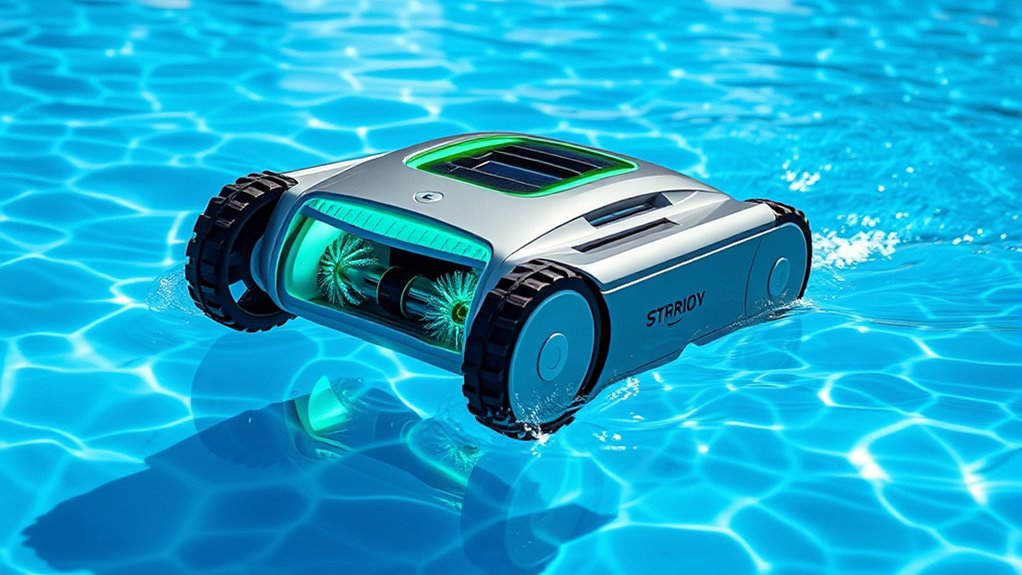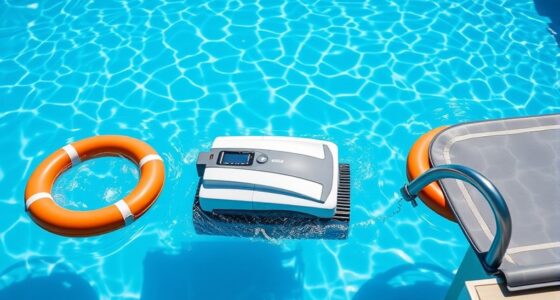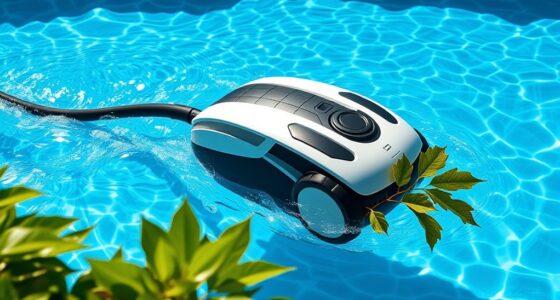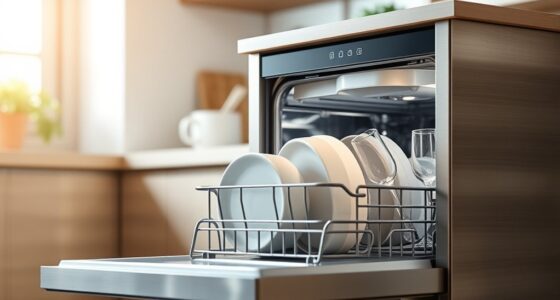In 2025, robotic pool cleaners are becoming smarter and more efficient with advanced mapping, AI learning, and user-friendly controls. They can navigate precisely, adapt to obstacles, and learn your pool’s layout to guarantee thorough cleaning. Smart sensors and companion apps let you schedule, monitor, and adjust cleaning remotely. With features like obstacle detection and energy efficiency, these cleaners make pool maintenance almost hands-off. Keep exploring to discover how these innovations can transform your pool care.
Key Takeaways
- Advanced smart navigation and mapping enable precise pool coverage and dynamic route optimization for efficient cleaning.
- AI learning capabilities adapt to seasonal debris patterns and target stubborn dirt for enhanced performance.
- User control apps provide real-time monitoring, scheduling, and remote operation for greater convenience.
- Integration of smart sensors and obstacle detection prevents damage to delicate features and outdoor furniture.
- Industry-wide improvements focus on energy efficiency, automation, and making robotic pool cleaners more reliable and user-friendly.

As technology continues to advance rapidly, robotic pool cleaners are becoming smarter and more efficient than ever before. One of the biggest developments driving this progress is smart navigation combined with AI integration. You’ll notice that new models no longer just follow random paths; instead, they map out your pool’s layout with precision, ensuring every inch gets cleaned. These cleaners leverage intelligent algorithms that adapt to your pool’s shape, size, and obstacles, making cleaning sessions faster and more thorough. Thanks to smart navigation, you no longer have to worry about missed spots or inefficient paths. Your robotic cleaner can now identify areas that need extra attention, adjusting its route dynamically to optimize coverage. Moreover, the integration of smart sensors features allows manufacturers to embed motivational messages or user guidance that enhances the user experience. Additionally, the use of advanced mapping technology enables these devices to create detailed layouts of your pool, further increasing cleaning accuracy. These innovations are also influenced by broader trends in smart technology, which continue to push the boundaries of automation and user convenience.
Smart navigation and AI make robotic pool cleaners more efficient, precise, and capable of adapting to your pool’s unique shape and obstacles.
AI integration takes this a step further by enabling these devices to learn from their environment over time. With each cleaning cycle, your robotic pool cleaner becomes more attuned to your pool’s specific needs. For example, if it detects certain stubborn dirt patches or debris around skimmer areas, it can prioritize those spots in future sessions. Some models even incorporate machine learning to recognize patterns, such as increased leaf fall during certain seasons, so they prepare accordingly. This smart adaptability means your pool stays cleaner with less manual intervention, giving you more time to enjoy your swim rather than constantly monitoring cleaning routines. Additionally, advancements in smart sensors allow these devices to better detect and respond to various debris types, further enhancing their cleaning efficiency.
Another advantage of these advancements is the seamless user experience. Many models with AI integration come with companion apps that allow you to schedule cleanings, monitor progress, or even control the cleaner remotely. You get real-time updates about cleaning status, battery life, or any issues that may arise. Plus, the AI-powered navigation systems often include obstacle detection, so your robot can avoid delicate pool features or outdoor furniture, preventing potential damage. Overall, the combination of smart navigation and AI integration makes these cleaners more autonomous, reliable, and efficient. Additionally, advancements in Kia Tuning, such as ECU remapping and suspension upgrades, reflect a broader trend of automotive technology becoming smarter and more adaptable, much like the evolving capabilities of robotic pool cleaners.
In 2025, expect these smart features to become standard across most high-end robotic pool cleaners. Manufacturers are continually refining AI algorithms to improve cleaning efficacy and energy efficiency. As a pool owner, this means fewer concerns about missed spots, reduced maintenance, and a more hands-off approach to pool care. With these cutting-edge technologies, your robotic cleaner isn’t just a gadget; it’s a smart assistant that keeps your pool pristine with minimal effort. As they become more sophisticated, you’ll find that your pool maintenance routines are simpler, faster, and more effective, freeing you up to enjoy your outdoor oasis without the hassle of manual cleaning.
Frequently Asked Questions
Are Robotic Pool Cleaners Eco-Friendly?
You might wonder if robotic pool cleaners are eco-friendly. Many models now use eco-conscious materials that reduce environmental impact. They also feature energy-efficient designs that lower energy consumption, making them more sustainable. By choosing a cleaner with these features, you help minimize your pool’s ecological footprint. Overall, modern robotic pool cleaners are increasingly designed to be eco-friendly, helping you maintain your pool while being mindful of the environment.
How Do AI Advancements Improve Cleaning Efficiency?
AI advancements boost your robotic pool cleaner’s efficiency by enhancing smart navigation and debris detection. With smarter navigation, your robot moves precisely around the pool, avoiding obstacles and covering the entire surface quickly. Improved debris detection allows it to identify and remove debris more effectively, saving time and energy. These innovations make your cleaner more reliable and thorough, ensuring your pool stays spotless with less effort on your part.
What Safety Features Are Standard in 2025 Models?
In 2025, robotic pool cleaners prioritize safety with standard features like smart navigation, which helps them avoid obstacles and prevent damage. These models also include user safety features such as automatic shut-off if lifted from the water or if they detect an issue. You’ll find sensors that monitor water levels and guarantee smooth operation, giving you peace of mind while maintaining your pool efficiently.
Can Robotic Cleaners Handle Algae-Heavy Pools?
Think of a robotic cleaner as your pool’s diligent gardener, ready to tackle algae-heavy waters. These machines are increasingly equipped with powerful brushes and advanced filters, making surface scrubbing and debris removal more efficient. While some models handle algae better than others, you should look for ones with strong suction and specialized algae filters. With the right robot, you can keep your pool sparkling, even amid stubborn algae blooms.
How Long Do Batteries Typically Last in New Models?
You’ll find that battery lifespan in new robotic pool cleaners typically lasts between 1 to 3 years, depending on usage and maintenance. To maximize battery life, follow maintenance tips like regularly cleaning the batteries and avoiding overcharging. Proper care guarantees your device performs efficiently and extends its lifespan, so you get the most out of your investment. Always check manufacturer guidelines for specific maintenance recommendations for your model.
Conclusion
Stay ahead of the game by embracing the latest trends in robotic pool cleaners for 2025. Whether it’s smarter navigation, eco-friendly features, or seamless connectivity, these innovations are designed to make your pool maintenance easier, more efficient, and more enjoyable. Keep exploring, keep upgrading, and keep enjoying crystal-clear waters. Because when you choose the best technology, you get the best results. Immerse yourself in the future of pool cleaning and make every swim a perfect one.









